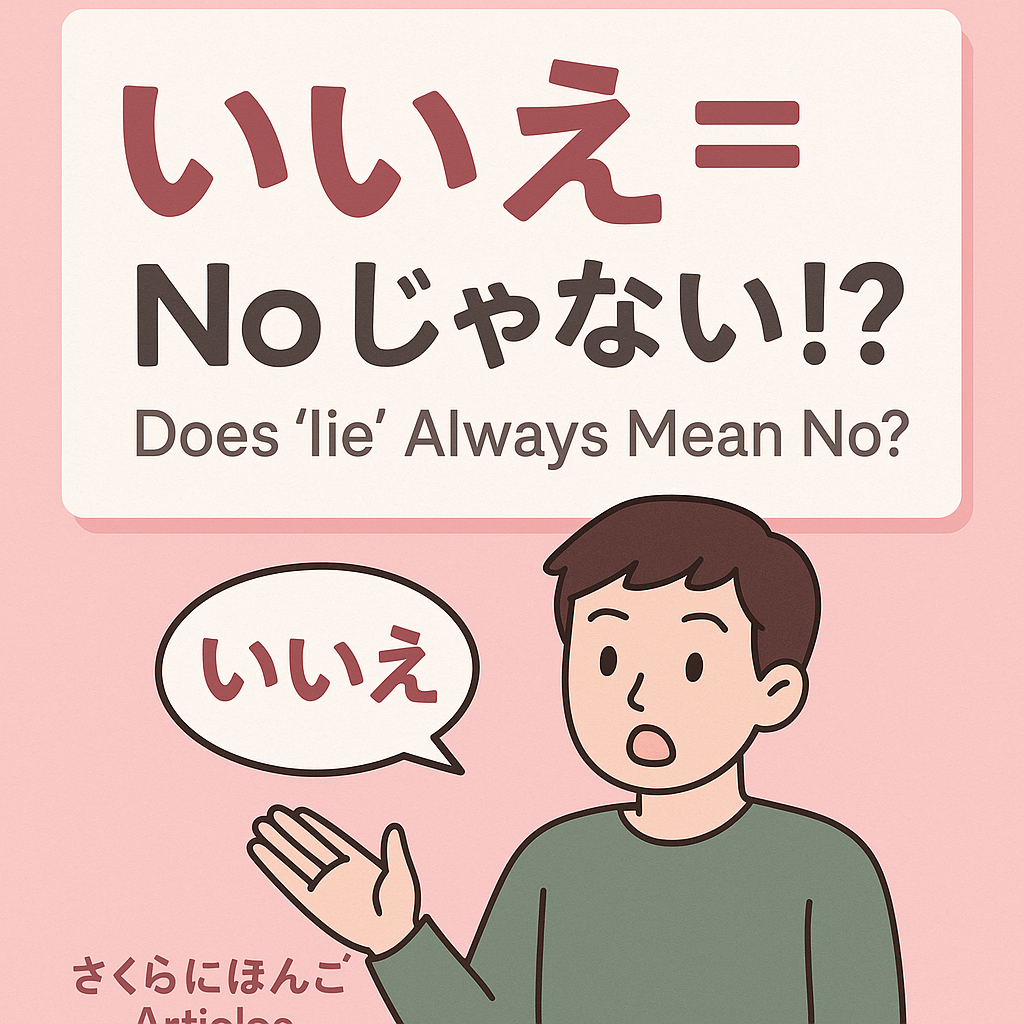はじめに / Introduction
日本語を学び始めると、まず「はい = Yes」「いいえ = No」と習うことが多いです。 しかし、実際の会話ではその対応関係が必ずしも成り立ちません。 教科書どおりに「いいえ」を使うと、時に冷たい印象や不自然な会話になることもあります。
In beginner Japanese lessons, we often learn “hai = yes” and “iie = no.” But in real conversations, this one-to-one relationship doesn’t always work. If you use “iie” exactly like “no,” it can sometimes sound too cold or unnatural.

基本の意味 / The Basic Meaning
「いいえ」は、相手の質問や提案を否定・拒否するときに使われます。 しかし、これが「いいえ」のすべてではありません。 日本語の会話文化では、「いいえ」には訂正・遠慮・謙遜・会話の調整といった役割もあります。
The basic function of “iie” is denial or refusal. But that’s not the whole picture. In Japanese conversation culture, “iie” can also mean correction, modesty, soft refusal, or even a way to manage the flow of conversation.
会話例1:否定の意味 / Example 1: Direct Denial
友達:「昨日、映画に行った?」
あなた:「いいえ、行きませんでした。」
Friend: “Did you go to the movies yesterday?”
You: “Iie, I didn’t go.”
典型的な否定の使い方です。Yes/No質問に対して事実を否定しています。
会話例2:「いいえ」で丁寧に断る / Example 2: Polite Refusal
店員:「袋はいりますか?」
客:「いいえ、大丈夫です。」
Clerk: “Would you like a bag?”
Customer: “Iie, it’s okay (I don’t need one).”
この「いいえ」は、英語の“No”より柔らかい響きを持ちます。 「結構です」「不要です」というニュアンスを含んでいます。
会話例3:訂正の「いいえ」 / Example 3: Correction
先生:「あなたは韓国から来ましたね?」
学生:「いいえ、日本から来ました。」
Teacher: “You are from Korea, right?”
Student: “Iie, I’m from Japan.”
この場合、「いいえ」は単なる拒否ではなく「それは違います」という訂正の意味を持ちます。
会話例4:謙遜の「いいえ」 / Example 4: Modesty
友達:「日本語がとても上手ですね!」
あなた:「いいえ、まだまだです。」
Friend: “Your Japanese is really good!”
You: “Iie, not at all (I still have a long way to go).”
日本人は褒められると、よく「いいえ」と答えて謙遜します。 これは英語の“No”とは異なり、相手に敬意を示す文化的表現です。
会話例5:遠回しの断り / Example 5: Soft Refusal
同僚:「今夜、一緒に飲みに行きませんか?」
あなた:「いいえ、ちょっと用事があるので…」
Colleague: “Shall we go for drinks tonight?”
You: “Iie, I have something to do…”
「No!」と強く拒否するのではなく、遠回しに断る柔らかい方法として「いいえ」を使っています。
会話例6:「いいえ」を言わない場合 / Example 6: When “Iie” is Omitted
実際の会話では、「いいえ」を省略して「結構です」「大丈夫です」など他の言葉に置き換えることがよくあります。
店員:「ポイントカードはお持ちですか?」
客:「ありません。」(「いいえ」を省略)
Clerk: “Do you have a point card?”
Customer: “I don’t.” (without saying “iie”)
このように日本語では「いいえ」を言わなくても、否定を表せる場合があります。
文化的な背景 / Cultural Nuance
- 日本人は直接的にNoと言うのを避ける傾向がある
- 「いいえ」の代わりに「ちょっと…」「今回は…」など曖昧な表現を使うことが多い
- 褒め言葉に対する「いいえ」は謙虚さのサイン
- ビジネス場面では「いいえ」より「恐れ入りますが」「難しいです」を使うこともある
Japanese people often avoid saying “no” directly. Instead of “iie,” they may use softer or vague expressions like “chotto…” or “konnkai wa…” to decline. In business, more formal alternatives are often used.
学習ポイントまとめ / Learning Summary
| 使い方 | 日本語例 | 英語ニュアンス |
|---|---|---|
| 否定 | いいえ、行きません。 | No, I won’t go. |
| 断り | いいえ、大丈夫です。 | No thanks / I don’t need it. |
| 訂正 | いいえ、日本人です。 | No, I’m Japanese. |
| 謙遜 | いいえ、まだまだです。 | Not at all / I still need to improve. |
ミニクイズ / Mini Quiz
次の英語を日本語でどう言いますか?「いいえ」を使ってみましょう。
- No, I don’t have a pen.
- No, I’m not Chinese, I’m Japanese.
- No, thank you. I don’t need it.
- No, not at all. I still have to study more.
(答えは記事の内容を参考にしてください!)
まとめ / Conclusion
「いいえ」は英語の“No”よりずっと広い意味を持っています。 否定・断り・訂正・謙遜など、文脈によってニュアンスが変わります。 単語だけでなく、その背後にある文化や会話習慣を理解することが、日本語学習の上達につながります。
“Iie” has a much wider range of meanings than the English “no.” It can deny, refuse, correct, or show modesty, depending on the situation. Understanding not only the word but also the cultural background is key to mastering Japanese.